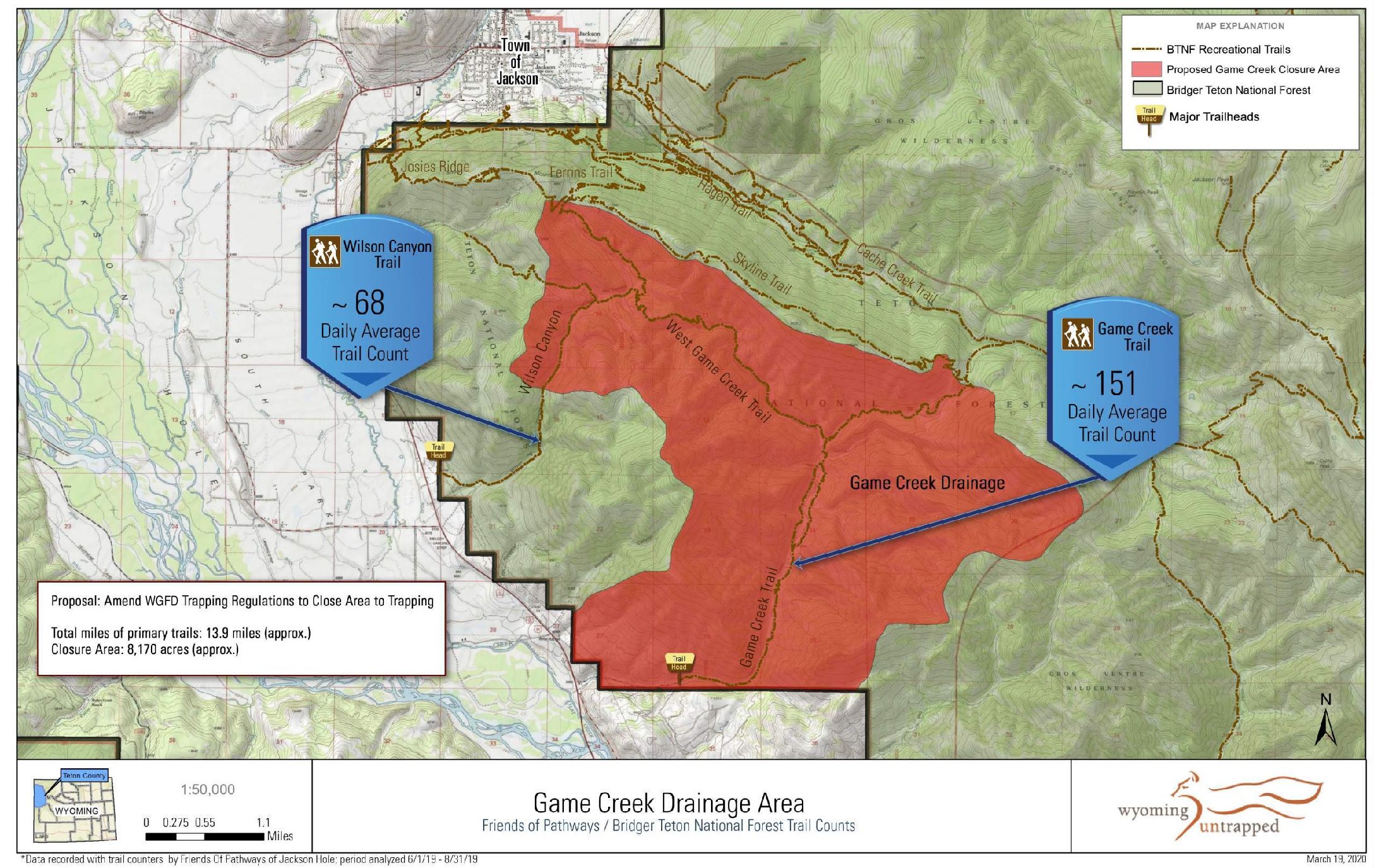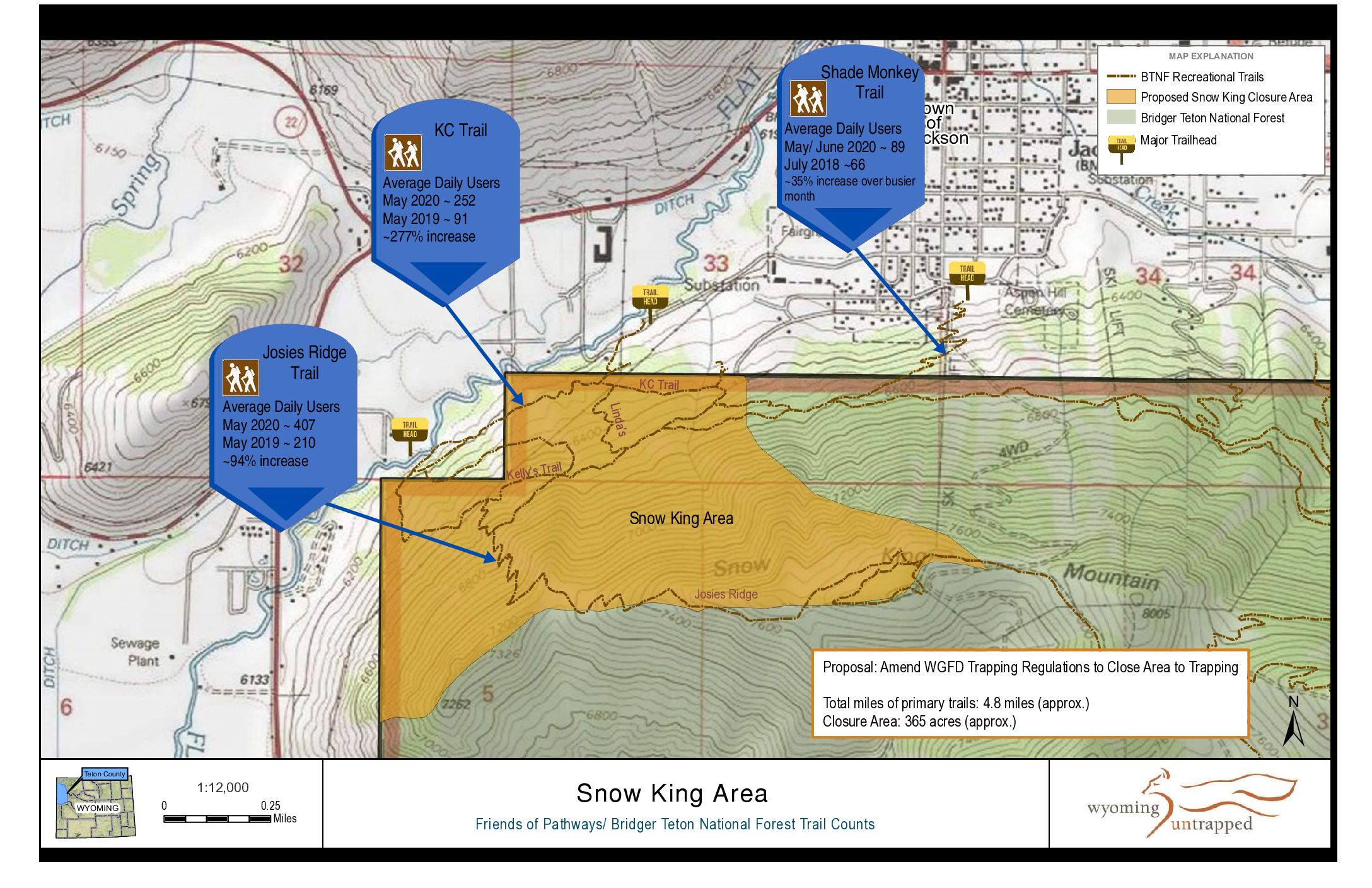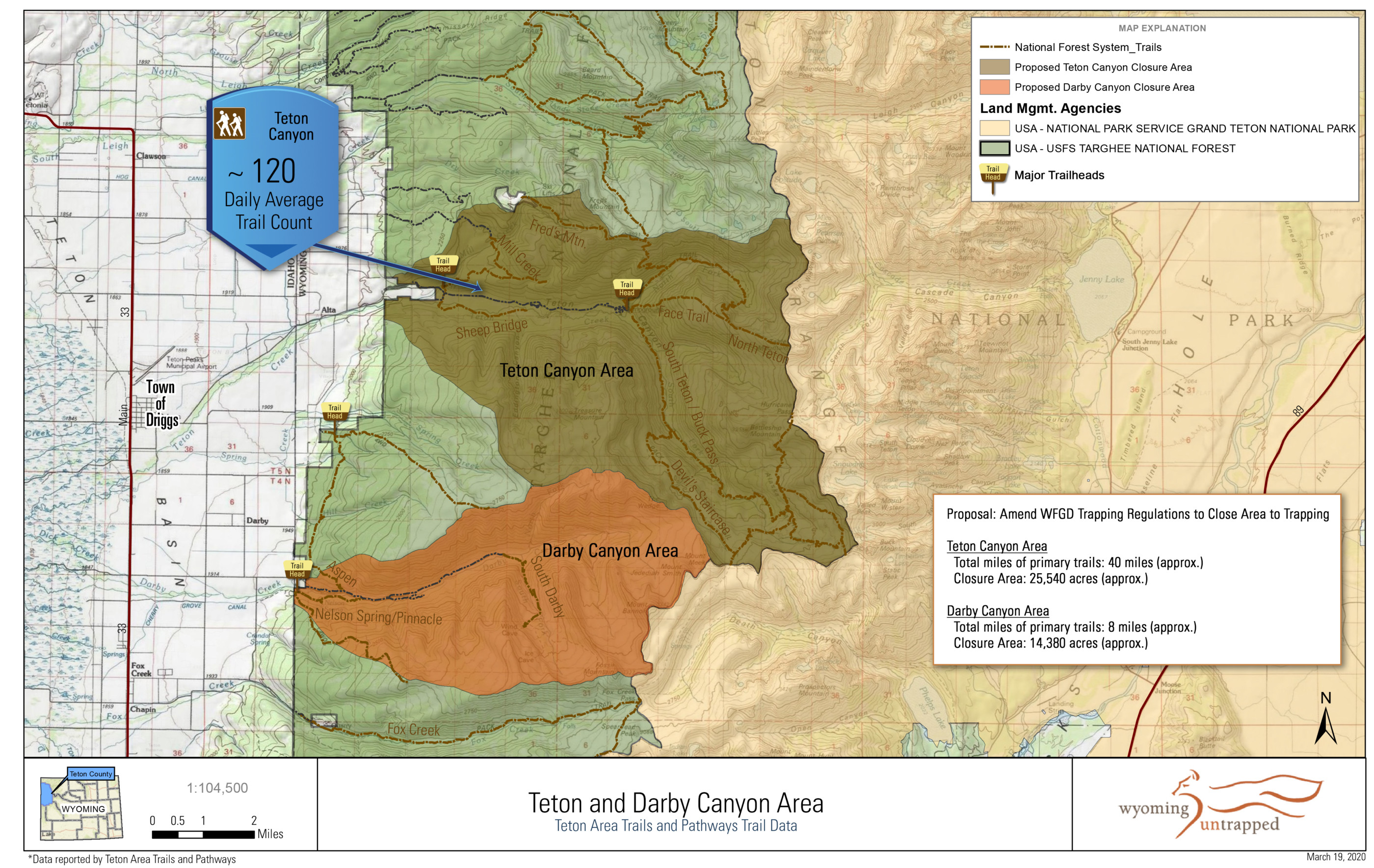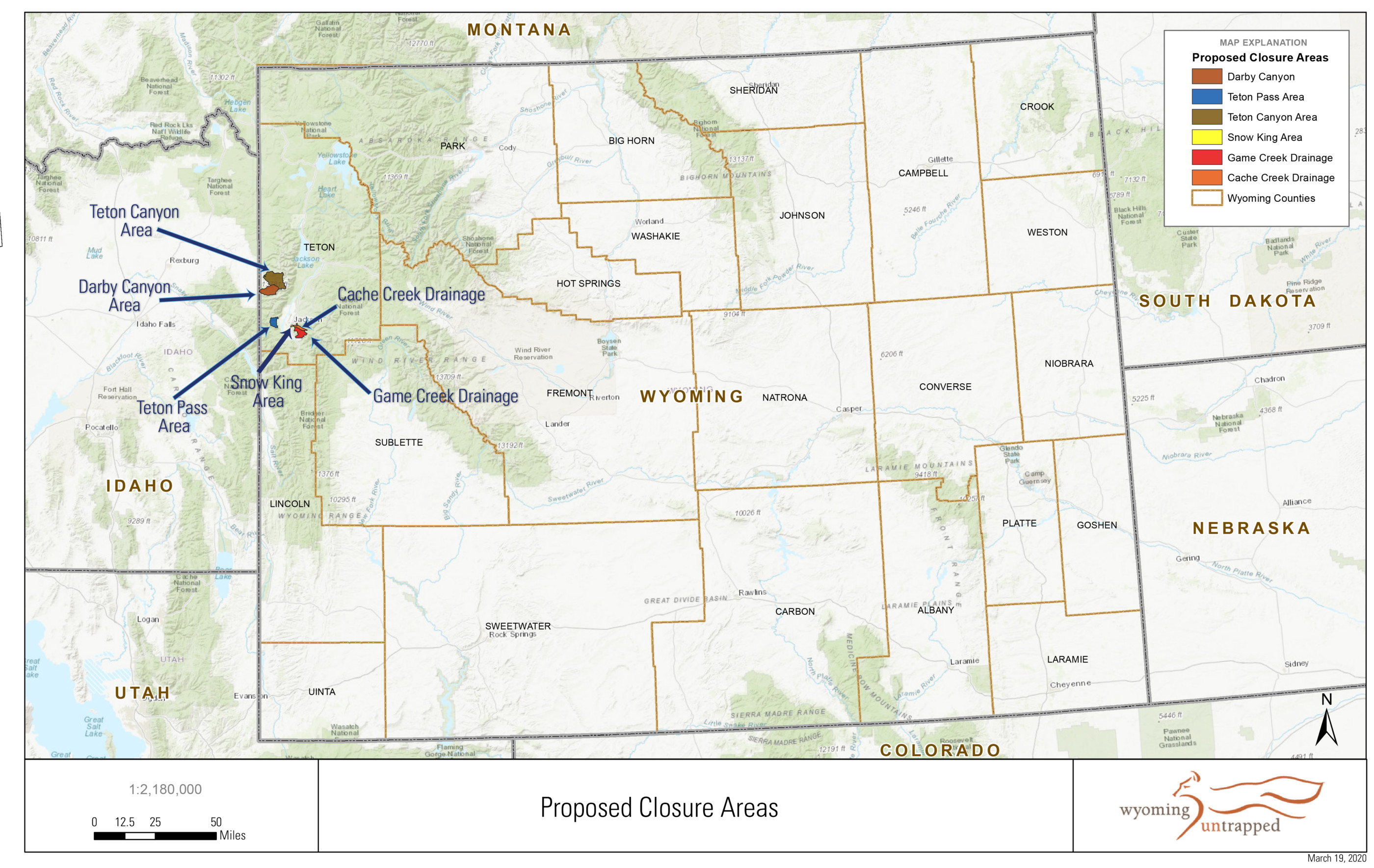
Trapping reform is a reality in 2020, Sixth step: WGFD to Present Final Recommendations to WGF Commission - November 17, 2020
Since January 2020, following a petition to the Wyoming Game and Fish Commission to consider trap-free reform in 2020 instead of the scheduled 2022, there are now a total of four groups advocating for trapping reform. Good news! Following an intensive process with public participation and meetings over several months, WGFD will provide final recommendations on November 2, 2020. We are in this process now, on a fast-track, and every step is breaking new ground.
WGFD revealed their final recommendations public on Monday, Nov 2. The WGF Commission will discuss the final recommendations at the Commission meeting online via ZOOM, Nov 17-18, 2020. They will vote to accept the regulations, or not, and the direction ahead.
Trapping Reform Statewide is Up and Running! We Need You! The Time is now!
Trapping Reform in Action 2020
TRAPPING REFORM IS ON IN WYOMING! BUT IT IS NOT ENOUGH!
Trapping reform recommendations are being presented to the WGF Commission on Nov 17, 2020. These recommendations are a step forward and should be treated as such, but although this is a shift, only baby steps are being recommended. However, critical actions are needed now!
After reviewing trapping reform recommendations by the internal WGFD committee, it’s clear that while some voices have been heard, this does not recognize the urgent need for action. We appreciate that mandatory trapping education may move forward. However, traps and snares will continue to remain legal directly on public trails, ensuring that additional injuries or death to pets will continue this year. Wild sentient animals will continue to suffer long brutal deaths with lengthy trap-check times. Non-target animal reporting will remain voluntary which does not allow for data-based management of furbearer animals.
Your letters, phone calls, conversations, and comments have moved us to this step, and now we need to ask for more!
We are asking for the Wyoming public to plan to attend the Commission meeting on Friday, November 17, 2020 via Zoom.
Wyoming Game and Fish Commission Meeting – Nov 17-18, ZOOM only
This meeting will be conducted via ZOOM video conferencing. To participate via ZOOM you must register at this link. Once registered, you will receive a confirmation email with instructions to join the meeting. Please note there are different links for each day.
To submit public comment at the Nov 17 meeting, you must fill out and submit the Advanced Agenda Item Comment Form (at the end of this link). Email to sheridan.todd@wyo.gov and john.kennedy@wyo.gov. Deadline is Friday, November 13, 2020.
Agenda Item #13. Presenters: Rick King, Chief, Wildlife Division and Jason Hunter, Lander Region Supervisor, Wildlife Division. Trapping Regulations Update . The Commission will be provided with an update on the Department’s efforts to review and evaluate trapping regulations. Specific recommendations will be presented to the Commission. 30 min. 4:00-4:30 p.m.
| Date | Location |
| November 17-18 | ZOOM link TBA |
Wildlife agencies need to act progressively on trapping reform 2020.
The incidental trapping of pets resulting in injuries and death continues to increase on our public lands. In the wake of these tragedies, current WGFD regulations leave recreationists believing that there is no or little accountability in the sport of trapping and that there is “no safe place for recreationists in Wyoming.” This dynamic is bad for the sport of trapping and bad for Wyoming.
TAKE ACTION Nov 17, 2020
ZOOM registration directions are attached to the meeting agenda. There are two different links, so you will need to register separately for each day.
PUBLIC COMMENTS AT THE MEETING:
To help facilitate your request to provide comments at the Wyoming Game and Fish Commission meeting, you must complete and submit an advanced comment form agenda item at the end of this link. Submit to John Kennedy @wyo.gov by November 13, 2020.
CONTACT EMAIL:
Jason Hunter: Lander Region wildlife supervisor and lead of the internal working group
Jason.Hunter@wyo.gov
307-335-2609
Richard King: Chief, Wildlife Division
Richard.King@wyo.gov
307-777-4684
WYOMING COMMISSIONERS:
Sherie Todd
Sheridan.Todd@wyo.gov
307-777-4632
peter.dube@wyo.gov (President)
patrick.crank@wyo.gov
mike.schmid@wyo.gov
david.rael@wyo.gov
gaylynn.byrd@wyo.gov
ralph.brokaw@wyo.gov
richard.ladwig@wyo.gov.
WYOMING GOVERNOR
Governor Mark Gordon
governor@wyo.gov
307-777-7434
Joe Budd
joe.budd@wyo.gov
WYOMING UNTRAPPED REQUESTED Trapping Reform LIST
Furbearer trapping regulations in the coming year will be adjusted and updated by the Wyoming Game and Fish Commission. WU has in the past, and continues to, assert that the following trapping regulation changes are necessary. Please stay tuned as we work through the process to create a safe and humane environment on our public lands.
- Trap Free Areas (Legislature and/or Commission) – Ask for trap-free areas for heavily used public recreation areas in Teton County, Fremont County and statewide. Access to trap free lands is a public right.
- 24–Hour Trap Checks ( Legislature) – Support of 24-hour trap checks statewide by writing your state representatives. Changing this law will require action by the Wyoming State Legislature. Wyoming is one of fourteen states that have not addressed the need for 24-hour trap checks. Wyoming state law currently requires a 72-hour check for leg hold traps and up to 13 days for snares and quick kill traps. Long trap check cycles result in suffering, pain, dehydration, starvation and loss of litters when a female/mother is trapped. For family pets that have been trapped, a 24-hour trap check could mean the difference between life and death.
- Trap Set Backs (Commission) – Trap setbacks of 300 feet off of busy public trails statewide. The public has a right to safe travel on trails, this right extends to their traveling companions, including dogs and livestock.
- Mandatory Signage (Legislature) – Caution signs, warning recreationalist, hunters, anglers and non-consumptive users of the dangers of trapping and specific trap placement on public lands, should be a mandatory requirement.
- Mandatory Reporting – Non Target and Pets (Legislature) – Reporting of all non-target species trapped and/or killed, including pets. Trappers and the Wyoming Game and Fish would argue that trapping is a management tool. Without mandatory reporting there is no data, without data there is no management.
- Mandatory Reporting – All Species (Legislature) – Reporting of all species trapped. See above. Trappers and the Wyoming Game and Fish would argue that trapping is a management tool. Without mandatory reporting there is no data, without data there is no management.
- Mandatory Trapper Education (Legislature) – Mandatory trapper education should be a requirement. Idaho’s mandatory Trapper Education Law went into effect July 1, 2018. This law requires first time trappers to complete a Trapper Education Course before purchasing a license. The class is designed to teach trappers how to “minimize impact on others” as well as best practices to avoid trapping, injuring and killing non-target animals. Wyoming is lagging behind our neighboring states on trap reform that would make our public lands safer for all.
- Ban of all trigger-loaded Power snares and Senneker snares (Legislature and/or Commission)– Power Snares and Senneker snares are extremely lethal, non-target species including pets are killed almost instantly. These traps should not be allowed on Wyoming’s landscape.
- Mandatory Conservation Stamp Purchase (Legislature) – “Funds from the conservation stamp purchase are used to support habitat and wildlife projects in Wyoming”. (Quote from WG&F website) Anglers and Hunters are required to purchase a Conservation Stamp, trappers are not. Trappers, who use the public’s wildlife for economic gain, should, more than any other user, be required to purchase a Conservation Stamp.
- Live Traps (Commission) – Live traps should be used wherever and whenever possible. Live traps would ensure that non target species, including protected and endangered species, can be released unharmed. Snares, leg hold, Conibear, Senneker and Power Snares are non-discriminate, they kill and maim regardless of species and protection status.
- Require all traps and snares to be removed at the end of trapping season (Legislature) – Thousands of traps and snares are left behind on our public landscapes at the end of trapping season. Some remain active. Trappers should be responsible for cleaning up all litter and hazards which they have placed on the land.
- Initiate statewide trapping reform stakeholder task force ( Legislature) – Trapping reform awareness statewide is growing rapidly which is initiating more public involvement and demand for immediate change.
- Review furbearer trapping regulations every two years ( Legislature) – Trapping regulations are scheduled for review on a three-year time frame. However, hunting and fishing are reviewed every two years.
Talking Points
Original words directly from your own heart and mind are more likely to be given consideration than words and phrases that sound scripted. See the take-action box above to email your comments to Jason Hunter, Lander Region wildlife supervisor and lead of the internal working group: jason.hunter@wyo.gov. If you prefer a personal connection with your Commissioner, feel free to call or email directly. Thank you!
WHY TRAPPING REFORM IS URGENT IN 2020
- The incidental trapping of pets resulting in injuries and death continues to increase on our public lands.
In the wake of these tragedies, current WGFD regulations leave recreationists believing that there is no or little accountability in the sport of trapping and that there is “no safe place for recreationists in Wyoming.” This dynamic is bad for the sport of trapping and bad for Wyoming. - There is an urgent need for action. After reviewing trapping reform recommendations by the internal WGFD committee, it’s clear that while some voices have been heard, this does not recognize the urgent need for action. We appreciate that mandatory trapping education may move forward. However, traps and snares will continue to remain legal directly on public trails, ensuring that additional injuries or death to pets will continue this year. Wild sentient animals will continue to suffer long brutal deaths with lengthy trap-check times. Non-target animal reporting will remain voluntary which does not allow for data-based management of furbearer animals.
- Our trapping reform list is long, but we, and other state advocates, will continue to promote as top priorities: Trap free areas on highly recreated public trails, trap and snare setbacks from all public trails, and mandatory reporting of all domestic and wild non-target animals. 24-hour trap checks for all traps and snares are urgent.
- Politics have grown tiresome for us all. It’s time for compassion instead. We remain hopeful that the honorable WGFC members will use their authority appropriately to address our urgent requests for action.
- Anyone who believes trapping should continue virtually unregulated are challenged to review our non-target incident database on our website, showing the needless death of hundreds of Wyoming wildlife.
- Over the last several years, WU has recorded 71+ reported dog trapping incidents in Wyoming.
Ten of these died. Seven of the 71+ incidents were in Teton County. There could be many more out there, but no official record exists. Just recently, two trapping incidents took place in a week. Just a couple days before the Christmas 2019 holiday, a dangerous trapline was set in the Cache Creek area adjacent to town. In this case, the trapper was cited for two violations and appeared in the Teton County court. A few days later, on January 4, 2020, a beloved pet, “Mac,” was caught in a lethal power snare and died within two minutes in the arms of Karen Zoller on public land in Fremont County. When WU asked for action on Mac’s case, some of the WGFD staff had never heard of these new snares, increasing the danger on our public lands. Emotions are high, and Wyoming residents are now reaching out to you and their electeds. - To avoid future incidents, we propose the establishment of criteria to guide trapping closures on “highly used public recreation areas” statewide,
Beginning with areas that have documented conflict histories, such as Teton County, Fremont County, Park County, and the towns Laramie, Pinedale and Rock Springs. Examples of “a highly used public area” in Teton County are Cache Creek, Game Creek, Old Pass Road, Snow King Trail Network, Teton Canyon and Darby Canyon. Today, the overall use of the Cache Creek trail system continues to rise and is estimated as high as 1526 daily, with an annual average of 400 people per day per a trail counter data summary 2019. GIS maps of these areas shows the trail count numbers, and the need for trapping closures. Overall Map. - As you consider the committee’s report, please be aware that the urgency Wyoming Untrapped brought to your attention last winter has not abated. Trail use continues to increase, on some trails as high as 277% over the numbers in our January 28, 2020 petition. With 2,498 Wyoming trapping licenses sold and 7,404 harvests in 2019, recreational trail users are far more common than trappers. We implore you, do not ignore non-consumptive users. The list of trapping reform options outlined in our petition continues to deserve your attention and your vote.
- The pure cruelty of trapping causing injuries, exposure, dehydration and mental stress, and often immense suffering.
All trap-check time requirements should be reduced to 24 hour trap checks, or should traps be eliminated from our landscapes. Jeremy Bentham famously asked, “The question is not, ‘Can they reason?’ Nor, ‘Can they talk?’ But, “can they suffer?'” - WU is asking for the ban of all trigger-loaded snares like the one that recently killed “Mac” in Fremont County. Our request compares any mechanical advantage assisted snare to the dangerous large size body grip traps, 330 conibears. The same non-selectivity and the same lethality. Dogs, cats, nontarget raptors and game animals and livestock will be more seriously injured or killed by these snares. The trappers can argue that the time until death of their target adult prime coyotes or bobcats will be reduced – – – but their ability to release young, or non target animals ( including domestic dogs) will be gone. And your ability to release you own dog while hiking or hunting before it suffocates will be reduced. These mechanically advantaged snares should be prohibited.
- On behalf of Wyoming Untrapped, Mac, and the citizens of Wyoming,
please consider restricting the use of all power snares, such as the Senneker spring snare or quick-kill snares, as soon as possible. - WGF Commission and WGF Department are our wildlife management leaders.
The failure to respond to the increase of land-use conflicts across Wyoming, specifically in Teton and Fremont Counties, perpetuates land use conflict. At the Lander WGFD workshop participants were reminded to be responsible land users and that their pets’ welfare is the sole responsibility of their owners. Blaming grieving residents for failure to see and avoid hidden lethal traps on public lands is ridiculous. We know Wyoming can do better and ask you to please step up and lead. - Given the danger present today by power snares hidden and loaded on public land,
we request that the topic of power snare restriction be considered immediately on all public and private land in the state. Given WGFC procedures and protocol, please add this topic to our request for trapping regulation amendment this year, instead of waiting until 2022. - Unacceptable deaths and severe injuries to non-target species; even animals released alive may later die from their injuries.
We don’t know how many non-target animals are trapped/snared, injured or killed in traps each year. All of the ~thousands of non-target animals should be required reporting by trappers. - Personal experience with a companion animal caught in a trap.
Warning signs should be required in areas where there are traps and snares to increase public safety. Traps are legal on all public trails where dogs can be walked. There should be 300 ft setbacks off trails, or trap-free areas where anyone can have a reasonable expectation of safety on our public lands. Trappers should be accountable for injuries or death to your pet. - Please consider the following trapping reform:
Trap-free areas for heavily used public recreation areas statewide, required signage where traps and snares are present, reporting of all species trapped, a ban of the new deadly trigger-loaded power snare and Senneker snare, reporting of all non-target species trapped and/or killed, including pets, trap setbacks of 500 feet off of busy public trails statewide, required purchase of Conservation Stamp for all trappers, use of live traps whenever possible, mandatory trapper education, and support of 24-hour trap checks statewide. - Our public lands should remain safe havens for all.
All people, pets and wildlife should have a reasonable expectation for safety on our public lands, which means trap-free areas for all.
- There are emerging trends in national wildlife management.
We value and protect wildlife as vital contributors to the health of our public landscapes, and for the intrinsic character and worth of all furbearing animals. We value the significant impact of wildlife watching on tourism – Wyoming’s 2nd largest industry. Wyoming’s wildlife management is not keeping pace with our modern society’s views. - Wildlife management should better represent the values of all citizens.
Our wildlife is a public treasure owned equally by all citizens and taxpayers. Therefore, it is not just that a few people are allowed to indiscriminately trap and kill this wildlife. Trapping and snaring greatly reduces the number of animals and thus the number of wildlife sightings for the public – depriving them of much pleasure. - There is an absence of sportsmanship, fair chase, and compassion in trapping.
Every animal in Wyoming, including endangered species, is a possible victim of traps and snares. It is not fair chase to not know your target, or to sit at home on a couch and wait for a catch. - The overall management of trapping is rarely cost-effective.
A furbearer trapping license costs $45 for all you can catch. How can that be cost-effective for our state? Perhaps one license should be required for each furbearer species and a limited quota. - Trapping, which is not based on a science foundation, does little or nothing for effectively managing any species population.
We don’t have a population count on our state furbearers, but we allow unlimited quotas. We should place quotas on all furbearer trapping. Where is the science? - Trapping lost its charm long ago as a Wyoming tradition, let alone an American one.
A growing debate about the legitimacy of trapping shows that a shift is coming. Trapping for fun, trophies, fur and feeding one’s ego is no longer acceptable by a growing modern population. - Trapping rarely serves any citizen other than the one who owns the trap.
It is time to create a statewide Trapping Advisory Committee to lend a citizen’s perspective to WGFD in reviewing the science and management of trapping, and predicting and anticipating public sentiment.









Dog Caught in Leghold, Vedauwoo Recreation Area, Medicine Bow National Forest, WY - Wyoming Untrapped
[…] Please consider becoming an advocate and taking action! Join our newsletter, and get involved. We need your […]
Dog, "Sheba", trapped in leghold, Tunnel Hill Rd, Fremont County - Wyoming Untrapped
[…] Please consider becoming an advocate and taking action! Join our newsletter, and get involved. We need your […]
Dog "Shia" caught in leghold, Chimney Park area, WY - Wyoming Untrapped
[…] Please consider becoming an advocate and taking action! Join our newsletter, and get involved. We need your […]
Dog caught in snare, Vedauwoo, Medicine Bow-Routt National Forest, WY - Wyoming Untrapped
[…] Please consider becoming an advocate and taking action! Join our newsletter, and get involved. We need your […]
Dog "Sugar" killed in Conibear, Tetonia, Idaho - Wyoming Untrapped
[…] Please consider becoming an advocate and taking action! Join our newsletter, and get involved. We need your […]
Dog, caught in snare, North Buford Road-state school trust land, Fremont County,WY - Wyoming Untrapped
[…] Please consider becoming an advocate and taking action! Join our newsletter, and get involved. We need your […]
Dog barely escaped snare incident, Vedauwoo, Medicine Bow-Routt National Forest, WY - Wyoming Untrapped
[…] Please consider becoming an advocate and taking action! Join our newsletter, and get involved. We need your […]
Dog "Poppy" Caught in Leghold, Pole Mountain, Medicine Bow National Forest - Wyoming Untrapped
[…] Please consider becoming an advocate and taking action! Join our newsletter, and get involved. We need your […]
Dog, caught in snare, Black Mountain Road south of Thermopolis, WY – Trapping Reform in Wyoming
[…] Please consider becoming an advocate and taking action! Join our newsletter, and get involved. We need your […]
Dog “Henry” caught in snare west of Ten Sleep, WY – Trapping Reform in Wyoming
[…] Please consider becoming an advocate and taking action! Join our newsletter, and get involved. We need your […]
Dog “Duke” caught in two legholds simultaneously in Cheyennee west of Ten Sleep, WY – Trapping Reform in Wyoming
[…] Please consider becoming an advocate and taking action! Join our newsletter, and get involved. We need your […]
Dog caught in snare near West Table Boat Ramp, WY – Trapping Reform in Wyoming
[…] Please consider becoming an advocate and taking action! Join our newsletter, and get involved. We need your […]